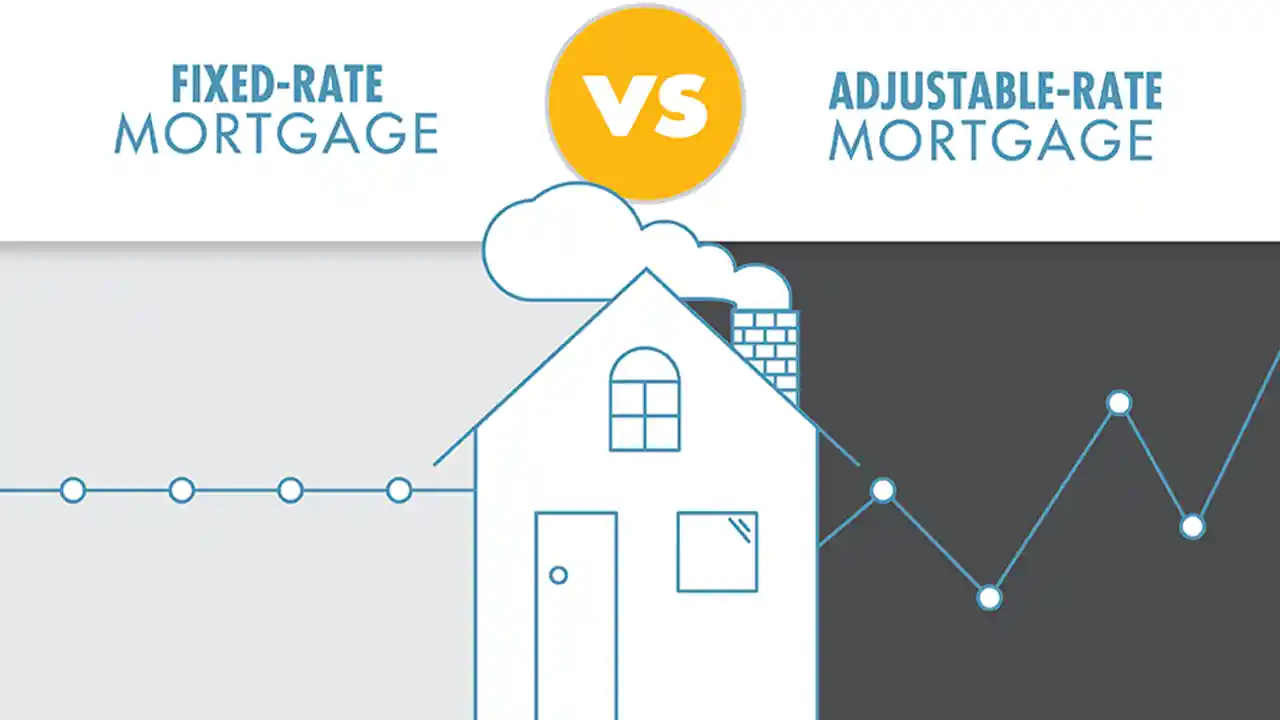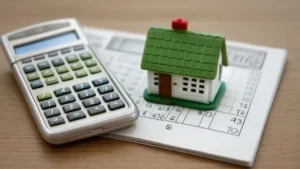Mortgagerateslocal.com – If you are planning to buy a home, one of the most important decisions you will have to make is choosing between a fixed vs adjustable-rate mortgage. These are the two main types of mortgages that have different interest rate structures and implications for your monthly payments and long-term costs.
A fixed-rate mortgage has an interest rate that remains unchanged throughout the loan’s term. Meanwhile, an adjustable-rate mortgage, or ARM, has an interest rate that can change periodically based on a specific index and margin.
An adjustable-rate mortgage usually starts with a lower interest rate than a fixed-rate mortgage, but the rate can adjust after a certain period of time. Both fixed vs adjustable-rate mortgage have their advantages and disadvantages.
We will provide you with more details and examples of fixed vs adjustable-rate mortgage in the following sections. We will also give you some tips on how to shop for the best mortgage deal and avoid common pitfalls. By the end of this blog post, you will have a better understanding of fixed vs adjustable-rate mortgage and how to choose the one that suits your needs and preferences.
How to Compare Fixed Vs Adjustable-Rate Mortgages
Before you decide between a fixed vs adjustable-rate mortgage , you need to compare the key features and costs of each option. Here are some of the factors you should consider:
1. Fixed Vs Adjustable-Rate Mortgag Interest rate
This is the percentage of the loan amount that you pay as interest each year. A fixed-rate mortgage has a constant interest rate for the entire term, while an adjustable-rate mortgage has a variable interest rate that can change periodically.
The interest rate of an ARM is usually composed of two parts: an index and a margin. The index is a benchmark rate that reflects the general market conditions, such as the prime rate, the LIBOR, or the Treasury rate. The margin is a fixed percentage that is added to the index to determine the actual interest rate of the ARM.
The index and the margin are specified in the loan agreement and cannot be changed by the lender. The interest rate of an ARM can also be affected by caps, which are limits on how much the rate can change at each adjustment period and over the life of the loan. Caps are designed to protect borrowers from extreme fluctuations in the interest rates and payments.
2. Fixed Vs Adjustable-Rate Mortgage Payment
This is the amount of money that you pay each month to repay the loan principal and interest. A fixed-rate mortgage has a constant payment for the entire term, while an adjustable-rate mortgage has a variable payment that can change periodically along with the interest rate.
The payment of an ARM can also be influenced by the type of amortization, which is the way the loan principal is reduced over time. There are two main types of amortization: fully amortizing and partially amortizing.
A fully amortizing loan has a payment that covers both the principal and the interest, and ensures that the loan balance will be zero at the end of the term. A partially amortizing loan has a payment that covers only part of the principal and the interest, and leaves a balance due at the end of the term, which is called a balloon payment. A partially amortizing loan can have a lower initial payment than a fully amortizing loan, but it also carries a higher risk of default and refinancing costs.
3. Fixed Vs Adjustable-Rate Mortgage Term
This is the length of time that you have to repay the loan. A fixed-rate mortgage usually has a term of 15, 20, or 30 years, while an adjustable-rate mortgage can have a term of any length, but typically ranges from 5 to 10 years.
The term of an ARM can be divided into two parts: the initial period and the adjustment period. The initial period is the time during which the interest rate and the payment of the ARM are fixed, and usually lasts from 3 to 10 years.
The adjustment period is the time during which the interest rate and the payment of the ARM can change, and usually occurs every 6 or 12 months. The term of an ARM can also affect the interest rate and the payment. Generally, the longer the initial period, the higher the interest rate and the payment. The shorter the adjustment period, the more frequently the interest rate and the payment can change.
4. Fixed Vs Adjustable-Rate Mortgage Costs
These are the fees and charges that you have to pay to get the loan and maintain it. Some of the common costs of a mortgage include the origination fee, the appraisal fee, the title fee, the closing costs, the points, the escrow account, the private mortgage insurance, and the prepayment penalty.
A fixed-rate mortgage and an adjustable-rate mortgage can have different costs depending on the lender and the loan terms. For example, an ARM may have a lower origination fee and points than a fixed-rate mortgage, but it may also have a higher escrow account and private mortgage insurance.
An ARM may also have a prepayment penalty, which is a fee that you have to pay if you pay off the loan early, either by selling the home or refinancing the mortgage. A prepayment penalty can discourage you from taking advantage of lower interest rates in the future.
To compare fixed vs adjustable-rate mortgage, you need to look at the total cost of each option over the time that you plan to stay in the home. You can use online calculators, such as the one provided by the Consumer Financial Protection Bureau, to compare the interest rates, payments, and costs of different mortgages.
You can also ask the lenders for a loan estimate, which is a standardized document that shows the key features and costs of the loan. A loan estimate can help you compare different loan offers and negotiate the best deal.
You should also review the closing disclosure, which is a document that confirms the final terms and costs of the loan before you sign the contract. You should make sure that the closing disclosure matches the loan estimate and that you understand all the fees and charges. If you have any questions or concerns, you should ask the lender or a trusted advisor for clarification.
The Pros and Cons
As we have seen, fixed vs adjustable-rate mortgage have different features and costs that can affect your financial situation and goals. To help you weigh the pros and cons of each option, we have summarized the main advantages and disadvantages of fixed vs adjustable-rate mortgage in the table below:
| Fixed-Rate Mortgage | Adjustable-Rate Mortgage |
|---|---|
| Pros | Pros |
| – Stability and predictability: You know exactly how much you have to pay each month and how much interest you will pay over the life of the loan. | – Lower initial payments: You can benefit from a lower interest rate and payment at the beginning of the loan, which can help you afford a larger or more expensive home. |
| – Ease of budgeting: You can plan your finances and savings more easily, as you do not have to worry about changing interest rates and payments. | – Flexibility: You can take advantage of lower interest rates and payments if the market conditions improve, or you can refinance or sell your home before the rate adjusts. |
| – Protection from rising interest rates: You can lock in a low interest rate and save money in the long run if the interest rates increase in the future. | – Potential savings: You can pay less interest and build equity faster if the interest rates drop in the future. |
| Cons | Cons |
| – Higher initial payments: You may have to pay a higher interest rate and payment at the beginning of the loan, which can limit your borrowing power and home choices. | – Uncertainty and risk: You do not know how much you have to pay each month and how much interest you will pay over the life of the loan, as they depend on how the market interest rates change. |
| – Less flexibility: You cannot benefit from lower interest rates and payments if the market conditions improve, unless you refinance or sell your home, which can incur additional costs and hassle. | – Difficulty of budgeting: You have to be prepared for changing interest rates and payments, which can affect your finances and savings. |
| – Opportunity cost: You may pay more interest and build equity slower if the interest rates drop in the future. | – Exposure to rising interest rates: You may have to pay a higher interest rate and payment in the future if the interest rates increase, which can strain your budget and reduce your equity. |
As you can see, fixed and adjustable-rate mortgages have their pros and cons, and there is no one-size-fits-all answer. The best option for you depends on your personal preferences, risk tolerance, and future plans. You should consider the following questions when choosing between a fixed and an adjustable-rate mortgage:
- How long do you plan to stay in your home? If you plan to stay in your home for a long time, more than 10 years, a fixed-rate mortgage may be a better option, as you can enjoy the stability and protection from rising interest rates. If you plan to stay in your home for a short time, less than 10 years, an adjustable-rate mortgage may be a better option, as you can take advantage of the lower initial payments and potential savings.
- How much can you afford to pay each month? If you have a stable and sufficient income, and you can afford to pay a higher monthly payment, a fixed-rate mortgage may be a better option, as you can save money in the long run and build equity faster. If you have a variable or limited income, and you need to pay a lower monthly payment, an adjustable-rate mortgage may be a better option, as you can benefit from the lower initial payments and flexibility.
- How comfortable are you with the risk of changing interest rates and payments? If you prefer certainty and peace of mind, and you do not want to worry about the market fluctuations, a fixed-rate mortgage may be a better option, as you can lock in a low interest rate and have a constant payment. If you are willing to take some risk and gamble on the market conditions, an adjustable-rate mortgage may be a better option, as you can benefit from the lower initial payments and potential savings.
- How do you expect the interest rates to change in the future? If you expect the interest rates to increase in the future, a fixed-rate mortgage may be a better option, as you can lock in a low interest rate and save money in the long run. If you expect the interest rates to decrease in the future, an adjustable-rate mortgage may be a better option, as you can pay less interest and build equity faster.
These questions can help you narrow down your choices and find the best mortgage option for you. However, you should also remember that the interest rates and the market conditions are unpredictable and can change at any time.
Therefore, you should always be prepared for any scenario and have a contingency plan in case your situation changes. You should also review your mortgage terms and conditions carefully and understand the risks and benefits of each option. If you have any doubts or questions, you should consult a professional financial advisor or a trusted mortgage lender for guidance and advice.
How to Shop for the Best Mortgage Deal
Once you have decided between a fixed and an adjustable-rate mortgage, you need to shop around for the best mortgage deal. The interest rate and the costs of a mortgage can vary significantly depending on the lender and the loan terms. Therefore, you should compare different loan offers and negotiate the best deal. Here are some tips on how to shop for the best mortgage deal:
- Start early: You should start shopping for a mortgage as soon as you know you want to buy a home. This will give you enough time to research the market, compare different options, and improve your credit score and financial situation. You should also get pre-approved for a mortgage, which is a letter from a lender that shows how much you can borrow and at what interest rate. A pre-approval can help you narrow down your home choices, make a realistic offer, and speed up the closing process.
- Shop around: You should shop around for a mortgage from different sources, such as banks, credit unions, mortgage brokers, online lenders, and government programs. You should compare the interest rates, the costs, and the terms of different loan offers. You should also check the reputation and the customer service of the lenders. You can use online tools, such as the one provided by the Consumer Financial Protection Bureau, to compare different loan offers and find the best deal. You can also ask for referrals from your friends, family, or real estate agent.
- Negotiate: You should negotiate the interest rate and the costs of the mortgage with the lenders. You can use the loan estimate and the closing disclosure as a basis for negotiation. You can ask the lenders to lower the interest rate, waive or reduce some of the fees, or offer you other incentives, such as a discount point or a credit. You can also ask the lenders to match or beat the offer of another lender. You should be prepared to walk away from a bad deal and look for a better one.
- Lock in: You should lock in the interest rate and the costs of the mortgage once you have found the best deal. A rate lock is a guarantee from the lender that they will honor the interest rate and the costs of the loan for a certain period of time, usually 30 to 60 days. A rate lock can protect you from the risk of rising interest rates and costs. However, a rate lock can also prevent you from taking advantage of lower interest rates and costs if the market conditions improve. Therefore, you should lock in the rate and the costs when you are confident that you have found the best deal and that you are ready to close the loan. You should also get a written confirmation of the rate lock from the lender and check the expiration date and the terms of the lock.
These tips can help you shop for the best mortgage deal and save money and hassle. However, you should also remember that the interest rate and the costs of the mortgage are not the only factors that you should consider when choosing a mortgage.
You should also consider the features and the benefits of the mortgage, such as the type, the term, the amortization, the caps, and the prepayment penalty. You should also consider your personal preferences, risk tolerance, and future plans.
You should choose a mortgage that suits your needs and goals, and that you can afford to pay. You should also review the mortgage contract carefully and understand the rights and responsibilities of both parties. If you have any doubts or questions, you should consult a professional financial advisor or a trusted mortgage lender for guidance and advice.
How to Avoid Common Pitfalls
Choosing between a fixed and an adjustable-rate mortgage can be a challenging and confusing task. There are many factors and variables that can affect your decision and your outcome. Therefore, you should be aware of the common pitfalls of fixed and adjustable-rate mortgages and how to avoid them. Here are some of the common pitfalls and how to avoid them:
- Not shopping around: One of the biggest mistakes that you can make is not shopping around for the best mortgage deal. As we have seen, the interest rate and the costs of a mortgage can vary significantly depending on the lender and the loan terms. Therefore, you should compare different loan offers and negotiate the best deal. You should also check the reputation and the customer service of the lenders. You can use online tools, such as the one provided by the Consumer Financial Protection Bureau, to compare different loan offers and find the best deal. You can also ask for referrals from your friends, family, or real estate agent.
- Not understanding the loan terms: Another common mistake that you can make is not understanding the loan terms and conditions. You should review the loan estimate and the closing disclosure carefully and make sure that you understand the interest rate, the payment, the term, the costs, and the features of the loan. You should also pay attention to the fine print and the hidden fees and charges. You should ask the lender or a trusted advisor for clarification and explanation if you have any doubts or questions. You should also read the mortgage contract carefully and understand the rights and responsibilities of both parties. You should not sign the contract until you are satisfied and confident that you have found the best deal and that you can afford to pay the loan.
- Not considering your future plans: Another common mistake that you can make is not considering your future plans and how they may affect your mortgage. You should consider how long you plan to stay in your home, how much you can afford to pay each month, how comfortable you are with the risk of changing interest rates and payments, and how you expect the interest rates to change in the future. You should also consider your life goals and events, such as getting married, having children, changing jobs, retiring, or relocating. You should choose a mortgage that suits your needs and goals, and that you can afford to pay. You should also be prepared for any scenario and have a contingency plan in case your situation changes. You should also review your mortgage periodically and evaluate your options. You may be able to refinance or modify your mortgage if the market conditions improve or if you face financial hardship.
- Not making timely payments: Another common mistake that you can make is not making timely payments on your mortgage. You should make your mortgage payments on time and in full every month. This will help you avoid late fees, penalties, and interest charges. It will also help you maintain a good credit score and a positive relationship with your lender. It will also help you build equity and reduce your loan balance. You should also pay more than the minimum payment if you can afford to do so. This will help you save money on interest and pay off your loan faster. You should also avoid making partial payments or skipping payments, as this can lead to default and foreclosure. If you have trouble making your payments, you should contact your lender as soon as possible and ask for help. You may be able to get a forbearance, a deferment, a repayment plan, or a loan modification. You may also be able to sell or transfer your home to avoid foreclosure.
These are some of the common pitfalls of fixed and adjustable-rate mortgages and how to avoid them. By following these tips, you can make a smart and informed decision and choose the best mortgage option for you.
You can also enjoy the benefits of homeownership and achieve your financial goals. You can also avoid the risks and costs of a bad mortgage and protect your home and your investment. You can also have peace of mind and confidence that you have made the right choice.
Conclusion
In conclusion, fixed vs adjustable-rate mortgage are two main types of mortgages that have different interest rate structures and implications for your monthly payments and long-term costs. A fixed-rate mortgage has an interest rate that remains unchanged throughout the loan’s term, while an adjustable-rate mortgage has an interest rate that can change periodically based on a specific index and margin. Both options have their pros and cons, and the best option for you depends on your personal preferences, risk tolerance, and future plans.




